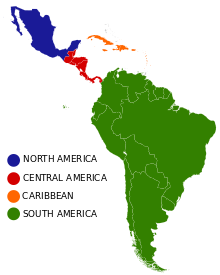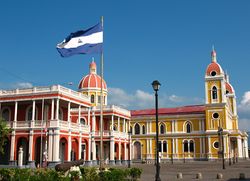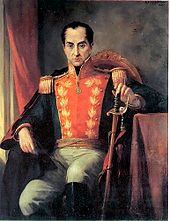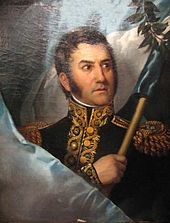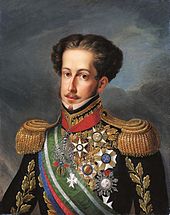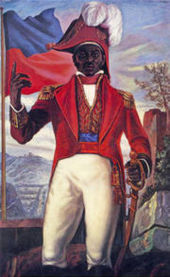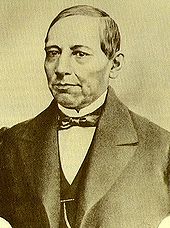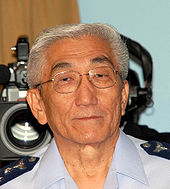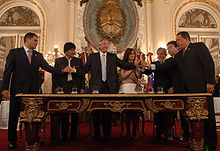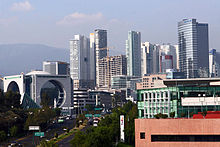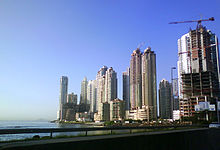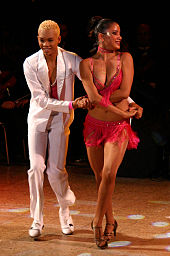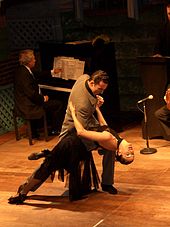
Latin America
About this schools Wikipedia selection
SOS Children have produced a selection of wikipedia articles for schools since 2005. To compare sponsorship charities this is the best sponsorship link.
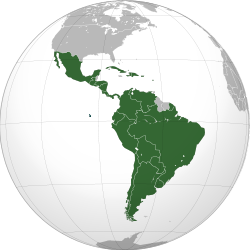 |
|
| Area | 21,069,501 km2 (8,134,980 sq mi) |
|---|---|
| Population | 589,018,078 |
| Pop. density | 27 /km2 (70 /sq mi) |
| Demonym | Latin American, American |
| Countries | 19 |
| Dependencies | 1 |
| Languages | Spanish, Portuguese, Quechua, Mayan languages, Guaraní, French, Aymara, Nahuatl, Italian, German and others. |
| Time Zones | UTC-2 to UTC-8 |
| Largest cities |
1. 2. 3. 4. 5. 6. 7. 8. 9. 10. |
Latin America (Spanish: América Latina or Latinoamérica; Portuguese: América Latina; French: Amérique latine, Dutch: Latijns-Amerika) is a region of the Americas where Romance languages (i.e., those derived from Latin) – particularly Spanish and Portuguese, and variably French – are primarily spoken. Latin America has an area of approximately 21,069,500 km2 (7,880,000 sq mi), almost 3.9% of the Earth's surface or 14.1% of its land surface area. As of 2010, its population was estimated at more than 590 million and its combined GDP at 5.16 trillion United States dollars (6.27 trillion at PPP). The Latin American expected economic growth rate is at about 5.7% for 2010 and 4% in 2011. According to Phelan (1968, p. 296), the term "Latin America" was first used in 1861 in La revue des races Latines, a magazine "dedicated to the cause of Pan-Latinism".
Etymology and definitions
The idea that a part of the Americas has a linguistic affinity with the Romance cultures as a whole can be traced back to the 1830s, in the writing of the French Saint-Simonian Michel Chevalier, who postulated that this part of the Americas was inhabited by people of a " Latin race", and that it could, therefore, ally itself with " Latin Europe" in a struggle with " Teutonic Europe", " Anglo-Saxon America" and " Slavic Europe". The idea was later taken up by Latin American intellectuals and political leaders of the mid- and late-nineteenth century, who no longer looked to Spain or Portugal as cultural models, but rather to France. The term was first used in Paris in an 1856 conference by the Chilean politician Francisco Bilbao and the same year by the Colombian writer José María Torres Caicedo in his poem "Two Americas. The term Latin America was supported by the French Empire of Napoleon III during the French invasion of Mexico, as a way to include France among countries with influence in America and to exclude Anglophone countries, and played a role in his campaign to imply cultural kinship of the region with France, transform France into a cultural and political leader of the area, and install Maximilian of Habsburg as emperor of the Second Mexican Empire. This term was also baptized in 1861 by French scholars in La revue des races Latines, a magazine dedicated to the Pan-Latinism movement.
In contemporary usage:
- In one sense, Latin America refers to territories in America where the Spanish or Portuguese languages prevail: Mexico, most of Central and South America, and in the Caribbean, Cuba, the Dominican Republic, and Puerto Rico – in summary, Hispanic America and Brazil. Latin America is, therefore, defined as all those parts of the Americas that were once part of the Spanish and Portuguese Empires. By this definition, Latin America is coterminous with Ibero-america ("Iberian America").
- Particularly in the United States, the term more broadly refers to all of the Americas south of the United States, thus including: English-speaking countries such as Belize, Jamaica, Barbados, Trinidad and Tobago, Guyana, Antigua and Barbuda, St. Lucia, Dominica, Grenada, St. Vincent and the Grenadines, and the Bahamas; French-speaking Haiti and Martinique, Guadeloupe, French Guiana; and the Dutch-speaking Curaçao, Aruba, St. Maarten and Suriname. (In the former Curaçao and Aruba, Papiamento – a predominantly Iberian-derived creole language – is spoken by the majority of the population.) This definition emphasizes a similar socioeconomic history of the region, which was characterized by formal or informal colonialism, rather than cultural aspects. (See, for example, dependency theory.) As such, some sources avoid this oversimplification by using the phrase "Latin America and the Caribbean" instead, as in the United Nations geoscheme for the Americas.
- In a more literal definition, which remains faithful to the original usage, Latin America designates all of those countries and territories in the Americas where a Romance language (i.e., languages derived from Latin, and hence the name of the region) is spoken: Spanish, Portuguese, and French, and the creole languages based upon these. Considering this definition, Quebec, in Canada, is technically part of Latin America as well. But this region is rarely considered so, since its history, distinctive culture, economy, geographical location and British-inspired political institutions are generally deemed too closely intertwined with the rest of Canada.
The distinction between Latin America and Anglo-America is a convention based on the predominant languages in the Americas by which Romance-language and English-speaking cultures are distinguished. Neither area is culturally or linguistically homogeneous; in substantial portions of Latin America (e.g., highland Peru, Bolivia, Guatemala, and Paraguay), Native American cultures and, to a lesser extent, Amerindian languages, are predominant, and in other areas, the influence of African cultures is strong (e.g., the Caribbean basin – including parts of Colombia and Venezuela) – and the coastal areas of Ecuador and Brazil.
Subdivisions
Latin America can be subdivided into several subregions based on geography, politics, demographics and culture. If defined as all of the Americas south of the United States, the basic geographical subregions are North America, Central America, the Caribbean and South America; the latter contains further politico-geographical subdivisions such as the Southern Cone and the Andean states. It may be subdivided on linguistic grounds into Hispanic America and Portuguese America.
History
Pre-Columbian history
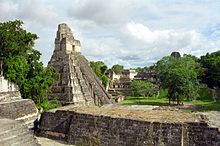
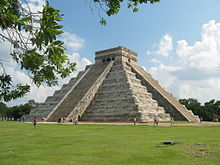
The earliest known settlement was identified at Monte Verde, near Puerto Montt in Southern Chile. Its occupation dates to some 14,000 years ago and there is some disputed evidence of even earlier occupation. Over the course of millennia, people spread to all parts of the continents. By the first millennium AD/ CE, South America's vast rainforests, mountains, plains and coasts were the home of tens of millions of people. The earliest settlements in the Americas are of the Las Vegas Culture from about 8000 BC and 4600 BC, a sedentary group from the coast of Ecuador, the forefathers of the more known Valdivia culture, of the same era. Some groups formed more permanent settlements such as the Chibchas (or "Muiscas" or "Muyscas") and the Tairona groups. These groups are in the circum Caribbean region. The Chibchas of Colombia, the Quechuas and Aymaras of Bolivia and Perú were the three indigenous groups that settled most permanently.
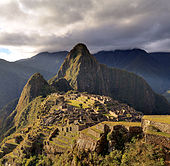
The region was home to many indigenous peoples and advanced civilizations, including the Aztecs, Toltecs, Caribs, Tupi, Maya, and Inca. The golden age of the Maya began about 250, with the last two great civilizations, the Aztecs and Incas, emerging into prominence later on in the early fourteenth century and mid-fifteenth centuries, respectively. The Aztec empire was ultimately the most powerful civilization known throughout the Americas, until its downfall in part by the Spanish invasion.
European colonization
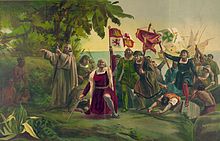
With the arrival of the Europeans following Christopher Columbus' voyages, the indigenous elites, such as the Incas and Aztecs, lost power to the heavy European invasion. Hernándo Cortés seized the Aztec elite's power with the help of local groups who did not favour the Aztec elite, and Francisco Pizarro eliminated the Incan rule in Western South America. The European powers of Spain and Portugal colonized the region, which along with the rest of the uncolonized world, was divided into areas of Spanish and Portuguese control by the line of demarcation in 1494, which gave Spain all areas to the west, and Portugal all areas to the east (the Portuguese lands in South America subsequently becoming Brazil).
By the end of the sixteenth century Spain and Portugal had been joined by others, including France, in occupying large areas of North, Central and South America, ultimately extending from Alaska to the southern tips of the Patagonia. European culture, customs and government were introduced, with the Roman Catholic Church becoming the major economic and political power to overrule the traditional ways of the region, eventually becoming the only official religion of the Americas during this period.
Epidemics of diseases brought by the Europeans, such as smallpox and measles, wiped out a large portion of the indigenous population. Historians cannot determine the number of natives who died due to European diseases, but some put the figures as high as 85% and as low as 25%. Due to the lack of written records, specific numbers are hard to verify. Many of the survivors were forced to work in European plantations and mines. Intermixing between the indigenous peoples and the European colonists was very common, and, by the end of the colonial period, people of mixed ancestry (mestizos) formed majorities in several colonies.
Independence (1804–1825)
In 1804, Haiti became the first Latin American nation to gain independence, following a violent slave revolt led by Toussaint L'ouverture on the French colony of Saint-Domingue. The victors abolished slavery. Haitian independence inspired independence movements in Spanish America.
By the end of the eighteenth century, Spanish and Portuguese power waned on the global scene as other European powers took their place, notably Britain and France. Resentment grew among the majority of the population in Latin America over the restrictions imposed by the Spanish government, as well as the dominance of native Spaniards (Iberian-born Peninsulares) in the major social and political institutions. Napoleon's invasion of Spain in 1808 marked a turning point, compelling Criollo elites to form juntas that advocated independence. Also, the newly independent Haiti, the second oldest nation in the New World after the United States, further fueled the independence movement by inspiring the leaders of the movement, such as Miguel Hidalgo y Costilla of México, Simón Bolívar of Venezuela and José de San Martín of Argentina, and by providing them with considerable munitions and troops.
Fighting soon broke out between juntas and the Spanish colonial authorities, with initial victories for the advocates of independence. Eventually these early movements were crushed by the royalist troops by 1810, including those of Miguel Hidalgo y Costilla in Mexico in the year 1810. Later on Francisco de Miranda in Venezuela by 1812. Under the leadership of a new generation of leaders, such as Simón Bolívar "The Liberator", José de San Martín of Argentina, and other Libertadores in South America, the independence movement regained strength, and by 1825, all Spanish America, except for Puerto Rico and Cuba, had gained independence from Spain. Brazil achieved independence with a constitutional monarchy established in 1822. In the same year in Mexico, a military officer, Agustín de Iturbide, led a coalition of conservatives and liberals who created a constitutional monarchy, with Iturbide as emperor. This First Mexican Empire was short-lived, and was followed by the creation of a republic in 1823.
Consolidation and liberal-conservative conflicts (1825–1900)
World wars (1914–1945)
Brazil's participation in World War II
After World War I, in which Brazil was an ally of the United States, Great Britain, and France, the country realized it needed a more capable army but didn't have the technology to create it. In 1919, the French Military Mission was established by the French Commission in Brazil. Their main goal was to contain the inner rebellions in Brazil. They tried to assist the army by bringing them up to the European military standard but constant civil missions did not prepare them for World War II.
Brazil President, Getúlio Vargas, wanted to industrialize Brazil allowing it to be more competitive with other countries. He reached out to Germany, Italy, France, and the United States to act as trade allies. Many Italian and German people immigrated to Brazil many years before World War II began thus creating a Nazi influence. The immigrants held high positions in government and the armed forces. It was recently found that 9,000 war criminals escaped to South America, including Croats, Ukrainians, Russians and other western Europeans who aided the Nazi war machine. Most, perhaps as many as 5,000, went to Argentina; between 1,500 and 2,000 are thought to have made it to Brazil; around 500 to 1,000 to Chile; and the rest to Paraguay and Uruguay. It was not a secret that Vargas had an admiration for Hitler's Nazi Germany and its Führer. He even let German Luftwaffe build secret air forces around Brazil, but he knew that he could never favour the Nazis because of their racism towards the large black population in Brazil. This alliance with Germany became Brazil's second best trade alliance behind the United States.
Brazil continued to try to remain neutral to the United States and Germany because it was trying to make sure it could continue to be a place of interest for both opposing countries. Brazil attended continental meetings in Buenos Aires, Argentina (1936); Lima, Peru (1938); and Havana, Cuba (1940) that obligated them to agree to defend any part of the Americas if they were to be attacked. Eventually Brazil decided to stop trading with Germany once Germany started attacking offshore trading ships resulting in Germany declaring a blockade against the Americas in the Atlantic Ocean. Furthermore, Germany also ensured that they would be attacking the Americas soon.
Once the German submarines attacked unarmed Brazilian trading ships, President Vargas met with United States President Franklin D. Roosevelt to discuss how they could retaliate. On January 22, 1942, Brazil officially ended all relations with Germany, Japan, and Italy, becoming a part of the Allies.
The Brazilian Expeditionary Force was sent to Naples, Italy to fight for democracy. Brazil was the only Latin American country to send troops to Europe. Initially, Brazil wanted to only provide resources and shelter for the war to have a chance of gaining a high postwar status but ended up sending 25,000 men to fight.
After World War II, the United States and Latin America continued to have a close relationship. For example, USAID created family planning programs in Latin America combining the NGOs already in place, providing the women in largely Catholic areas access to contraception.
Involvement in World War II
There was Nazi influence in certain parts of the country, but Jewish migration from Europe during the war continued. Only a small population of people recognized or knew about the Holocaust. Furthermore, there were numerous military bases built by the U.S, but also by the Germans, during the war. Even now there are still remaining bombs from the war, which needed to be destroyed.
Cold War (1946–1990)
Economy
The Great Depression caused Latin America to grow at a slow rate, separating it from leading industrial democracies. The two world wars and U.S. Depression also made Latin American countries favour internal economic development, leading Latin America to adopt the policy of import substitution industrialization. Countries also renewed emphasis on exports. Brazil began selling automobiles to other countries, and some Latin American countries set up plants to assemble imported parts, letting other countries take advantage of Latin America's low labor costs. Colombia began to export flowers, emeralds and coffee grains and gold, becoming the world's second leading flower exporter.
Economic integration was called for, to attain economies that could compete with the economies of the U.S or Europe. Starting in the 1960s with the Latin American Free Trade Association and Central American Common Market, Latin American countries worked toward economic integration.
Reforms
Large countries like Argentina called for reforms to lessen the disparity of wealth between the rich and the poor, which has been a long problem in Latin America that stunted economic growth.
Advances in public health caused an explosion of population growth, making it difficult to provide social services. Education expanded, and social security systems introduced, but benefits usually went to the middle class, not the poor. As a result, disparity of wealth increased. Increasing inflation and other factors caused countries to be unwilling to fund social development programs to help the poor.
Bureaucratic authoritarianism
Bureaucratic authoritarianism was practiced in Brazil after 1964, in Argentina, and in Chile under Augusto Pinochet, in a response to harsh economic conditions. It rested on the conviction that no democracy could take the harsh measures to curb inflation, reassure investors, and quicken economic growth quickly and effectively. Though inflation fell sharply, industrial production dropped with the decline of official protection.
U.S. Relations
After World War II and the beginning of a Cold War between the U.S. and the Soviet Union, U.S. diplomats became interested in Asia, Africa, and Latin America, and frequently waged proxy wars against the Soviet Union in these countries. The U.S. sought to stop the spread of communism. Latin Americans generally resented the U.S. superiority over them. Latin America also complained of the U.S. support to locals in overthrowing nationalist governments, and intervention through the CIA. Still, Latin America respected the U.S. during this time, and Latin American countries generally sided with the U.S., even though they complained of being neglected by the U.S.'s concern with communism in Europe and Asia, not Latin America. In 1947, the U.S. Congress passed the National Security Act, which created the National Security Council in response to the United States's growing obsession with anti-communism.
In 1954, when Jacobo Arbenz of Guatemala accepted the support of communists and attacked holdings of the United Fruit Company, the U.S. decided to assist Guatemalan counterrevolutionaries in overthrowing Arbenz. These interventionist tactics featured use of the CIA rather than the military, which would be used in Latin America for the majority of the Cold War in events like the overthrow of Salvador Allende. Latin America was more concerned with issues of economic development, while the United States focused on fighting communism, even though the presence of communism was small in Latin America.
Cuban Revolution
By 1959, Cuba was afflicted with a corrupt dictatorship under Batista, and Fidel Castro ousted Batista that year and set up the first communist state in the hemisphere. The U.S. imposed a trade embargo on Cuba, and combined with Castro's expropriation of private enterprises, this was detrimental to the Cuban economy. Around Latin America, rural guerrilla conflict and urban terrorism increased, inspired by the Cuban example. The United States put down these rebellions by supporting Latin American countries in their counter guerrilla operations through the Alliance for Progress launched by President John F. Kennedy. This thrust appeared to be successful. A Marxist, Salvador Allende, became president of Chile in 1970, but was overthrown three years later in a military coup. Despite civil war, high crime and political instability, most Latin American countries eventually adopted democracies besides Cuba.
Bay of Pigs Invasion
Encouraged by the Guatemala success, Kennedy, in 1960, decided to launch an attack on Cuba. The Bay of Pigs invasion was an abortive invasion of Cuba in 1961, financed by the U.S. through the CIA, to overthrow Castro. The incident proved to be very embarrassing for the new Kennedy administration.
Alliance for Progress
President John F. Kennedy initiated the Alliance for Progress in 1961, to establish economic cooperation between the U.S. and Latin America. The Alliance would provide $20 billion for reform in Latin America, and counterinsurgency measures. Instead, the reform failed because of the simplistic theory that guided it and the lack of experienced American experts who could understand Latin American customs.
Cuban missile crisis
The Cuban Missile crisis nearly brought the U.S. and the Soviet Union to war in October 1962. Soviet premier Nikita Khrushchev had installed several missiles in Cuba that could hit most of the Eastern United States. President Kennedy decided to place a naval blockade on Cuba to prevent further Soviet shipments of missiles. In the end, Khrushchev submitted, taking missiles away. In return, Kennedy agreed never to invade Cuba, and to withdraw nuclear-arms from Turkey.
Washington Consensus
The set of specific economic policy prescriptions that were considered the "standard" reform package were promoted for crisis-wracked developing countries by Washington, D.C.-based institutions such as the International Monetary Fund (IMF), World Bank, and the US Treasury Department during the 1980s and 1990s.
In recent years, several Latin American countries led by socialist or other left wing governments – including Argentina and Venezuela – have campaigned for (and to some degree adopted) policies contrary to the Washington Consensus set of policies. (Other Latin countries with governments of the left, including Brazil, Chile and Peru, have in practice adopted the bulk of the policies.) Also critical of the policies as actually promoted by the International Monetary Fund have been some U.S. economists, such as Joseph Stiglitz and Dani Rodrik, who have challenged what are sometimes described as the "fundamentalist" policies of the International Monetary Fund and the US Treasury for what Stiglitz calls a "one size fits all" treatment of individual economies.
The term has become associated with neoliberal policies in general and drawn into the broader debate over the expanding role of the free market, constraints upon the state, and US influence on other countries' national sovereignty.
This politico-economical initiative was institutionalized in North America by the 1994 NAFTA, and elsewhere in the Americas through a series of like agreements. The comprehensive Free Trade Area of the Americas project, however, was rejected by most South American countries at the 2005 4th Summit of the Americas.
Turn to the Left
In most countries, since the 2000s left-wing political parties have risen to power. Hugo Chávez in Venezuela, Ricardo Lagos and Michelle Bachelet in Chile, Lula da Silva and Dilma Rousseff in Brazil, Néstor Kirchner and his wife Cristina Fernández in Argentina, Tabaré Vázquez and José Mujica in Uruguay, Evo Morales in Bolivia, Daniel Ortega in Nicaragua, Rafael Correa in Ecuador, Fernando Lugo in Paraguay, Manuel Zelaya in Honduras (removed from power by a coup d'état), and Mauricio Funes in El Salvador are all part of this wave of left-wing politicians who often declare themselves socialists, Latin Americanists, or anti-imperialists (often implying opposition to US policies towards the region). A development of this has been the creation of the eight-member ALBA alliance, or " The Bolivarian Alliance for the Peoples of Our America" (Spanish: Alianza Bolivariana para los Pueblos de Nuestra América) by some of the countries already mentioned. By 2011, only Chile ( Sebastián Piñera), Honduras ( Roberto Micheletti), Colombia ( Juan Manuel Santos), and Panama ( Ricardo Martinelli) had right-wing governments.
The return of social movements
In 1982, Mexico announced that it could not meet its foreign debt payment obligations, inaugurating a debt crisis that would discredit Latin American economies throughout the decade. This debt crisis would lead to neoliberal reforms that would instigate many social movements in the region. A "reversal of development" reigned over Latin America, seen through negative economic growth, declines in industrial production, and thus, falling living standards for the middle and lower classes. Governments made financial security their primary policy goal over social security, enacting new neoliberal economic policies that implemented privatization of previously national industries and informalization of labor. In an effort to bring more investors to these industries, these governments also embraced globalization through more open interactions with the international economy. Significantly, as democracy spread across much of Latin America, the realm of government more inclusive (a trend that proved conductive to social movements), the economic ventures remained exclusive to a few elite groups within society. Neoliberal restructuring consistently redistributed income upward while denying political responsibility to provide social welfare rights, and though development projects took place throughout the region, both inequality and poverty increased. Feeling excluded from these new projects, the lower classes took ownership of their own democracy through a revitalization of social movements in Latin America.
Both urban and rural populations had serious grievances as a result of the above economic and global trends and have voiced them in mass demonstrations. Some of the largest and most violent of these have been protests against cuts in urban services, such as the Caracazo in Venezuela and the Argentinazo in Argentina.
Rural movements have made diverse demands related to unequal land distribution, displacement at the hands of development projects and dams, environmental and indigenous concerns, neoliberal agricultural restructuring, and insufficient means of livelihood. These movements have benefited considerably from transnational support from conservationists and INGOs. The Movement of Rural Landless Workers (MST), is perhaps the largest contemporary Latin American social movement. As indigenous populations are primarily rural, indigenous movements account for a large portion of rural social movements, including the Zapatista rebellion in Mexico, the Confederation of Indigenous Nationalities of Ecuador ( CONAIE), indigenous organizations in the Amazon region of Ecuador and Bolivia, pan-Mayan communities in Guatemala, and mobilization by the indigenous groups of Yanomami peoples in the Amazon, Kuna peoples in Panama, and Altiplano Aymara and Quechua peoples in Bolivia. Other significant types of social movements include labor struggles and strikes, such as recovered factories in Argentina, as well as gender-based movements such as the Mothers of the Plaza de Mayo in Argentina and protests against maquila production, which is largely a women's issue because of how it draws on women for cheap labor.
These various social movements have continued today along with a broader political shift to the left. They are credited with raising social awareness across the globe of important issues affecting indigenous peoples in Latin America and through their work with NGOs and other international organizations. Moreover, they have provided tangible alternatives to the principles of neoliberalism, spurring constitutional changes and legislative policy while demonstrating the merits of active representative democracies.
Commodity boom and increasing relations with China
The 2000s commodities boom caused positive effects for many Latin American economies. Another trend is the rapidly increasing importance of the relations with China.
Demographics
| Historical populations | ||
|---|---|---|
| Year | Pop. | ±% |
| 1750 | 16,000,000 | — |
| 1800 | 24,000,000 | +50.0% |
| 1850 | 38,000,000 | +58.3% |
| 1900 | 74,000,000 | +94.7% |
| 1950 | 167,000,000 | +125.7% |
| 1999 | 511,000,000 | +206.0% |
| Source: "UN report 2004 data" (PDF). | ||
Ethnic groups
The inhabitants of Latin America are of a variety of ancestries, ethnic groups, and races, making the region one of the most diverse in the world. The specific composition varies from country to country: many have a predominance of European-Amerindian, or Mestizo, population; in others, Amerindians are a majority; some are dominated by inhabitants of European ancestry; and some countries' populations are primarily Mulatto. Black, Asian, and Afro-Amerindian (historically sometimes called Zambo) minorities are also identified regularly. People with European ancestry are the largest single group, and along with people of part-European ancestry, they combine to make up approximately 80% of the population, or even more.
Language
Spanish and Portuguese are the predominant languages of Latin America. Spanish is spoken as first language by about 60% of the population, Portuguese is spoken by about 34% of the population and about 6% of the population speak other languages such as Quechua, Mayan languages, Guaraní, Aymara, Nahuatl, English, French, Dutch and Italian. Portuguese is spoken only in Brazil ( Brazilian Portuguese), the biggest and most populous country in the region. Spanish is the official language of most of the rest of the countries on the Latin American mainland ( Spanish language in the Americas), as well as in Cuba, Puerto Rico (where it is co-official with English), and the Dominican Republic. French is spoken in Haiti and in the French overseas departments of Guadeloupe, Martinique and Guiana, and the French overseas collectivity of Saint Pierre and Miquelon; it is also spoken by some Panamanians of Afro-Antillean descent. Dutch is the official language in Suriname, Aruba, and the Netherlands Antilles. (As Dutch is a Germanic language, these territories are not necessarily considered part of Latin America.)
Native American languages are widely spoken in Peru, Guatemala, Bolivia, Paraguay and Mexico, and to a lesser degree, in Panama, Ecuador, Brazil, Colombia, Venezuela, Argentina, and Chile amongst other countries. In Latin American countries not named above, the population of speakers of indigenous languages tend to be very small or even non-existent (e.g. Uruguay). Mexico is possibly the only country that contains a wider variety of indigenous languages than any Latin American country, but the most spoken language is Nahuatl.
In Peru, Quechua is an official language, alongside Spanish and any other indigenous language in the areas where they predominate. In Ecuador, while holding no official status, the closely related Quichua is a recognized language of the indigenous people under the country's constitution; however, it is only spoken by a few groups in the country's highlands. In Bolivia, Aymara, Quechua and Guaraní hold official status alongside Spanish. Guaraní, along with Spanish, is an official language of Paraguay, and is spoken by a majority of the population (who are, for the most part, bilingual), and it is co-official with Spanish in the Argentine province of Corrientes. In Nicaragua, Spanish is the official language, but on the country's Caribbean coast English and indigenous languages such as Miskito, Sumo, and Rama also hold official status. Colombia recognizes all indigenous languages spoken within its territory as official, though fewer than 1% of its population are native speakers of these languages. Nahuatl is one of the 62 native languages spoken by indigenous people in Mexico, which are officially recognized by the government as "national languages" along with Spanish.
Other European languages spoken in Latin America include: English, by some groups in Puerto Rico, as well as in nearby countries that may or may not be considered Latin American, like Belize and Guyana; German, in southern Brazil, southern Chile portions of Argentina and Paraguay; Italian, in Brazil, Argentina, and Uruguay; and Welsh, in southern Argentina.
In several nations, especially in the Caribbean region, creole languages are spoken. The most widely spoken creole language in Latin America and the Caribbean is Haitian Creole, the predominant language of Haiti; it is derived primarily from French and certain West African tongues with some Amerindian and Spanish influences as well. Creole languages of mainland Latin America, similarly, are derived from European languages and various African tongues.
Religion
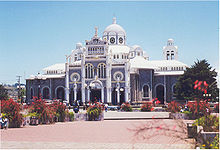
The vast majority of Latin Americans are Christians, mostly Roman Catholics belonging to the Latin Rite. About 70% of the Latin American population consider themselves Catholic. Membership in Protestant denominations is increasing, particularly in Brazil, Panamá and Venezuela.
Migration
Due to economic, social and security developments that are affecting the region in recent decades, the focus is now the change from net immigration to net emigration. About 10 million Mexicans live in the United States. 28.3 million Americans listed their ancestry as Mexican as of 2006. According to the 2005 Colombian census or DANE, about 3,331,107 Colombians currently live abroad. The number of Brazilians living overseas is estimated at about 2 million people. An estimated 1.5 to two million Salvadorans reside in the United States. At least 1.5 million Ecuadorians have gone abroad, mainly to the United States and Spain. Approximately 1.5 million Dominicans live abroad, mostly in the United States. More than 1.3 million Cubans live abroad, most of them in the United States. It is estimated that over 800,000 Chileans live abroad, mainly in Costa Rica, Mexico and Sweden. Other Chilean nationals may be located in countries like Spain and Sweden. An estimated 700,000 Bolivians were living in Argentina as of 2006 and another 33,000 in the United States. Central Americans living abroad in 2005 were 3,314,300, of which 1,128,701 were Salvadorans, 685,713 were Guatemalans, 683,520 were Nicaraguans, 414,955 were Hondurans, 215,240 were Panamanians, 127,061 were Costa Ricans and 59,110 were Belizeans.
For the period 2000–2005, Chile, Costa Rica, Panama, and Venezuela were the only countries with global positive migration rates, in terms of their yearly averages.
Education
Despite significant progress, education coverage remains unequal in Latin America. The region has made great progress in educational coverage; almost all children attend primary school and access to secondary education has increased considerably. Most educational systems in the region have implemented various types of administrative and institutional reforms that have enabled reach for places and communities that had no access to education services in the early 1990s.
However, there are still 23 million children in the region between the ages of 4 and 17 outside of the formal education system. Estimates indicate that 30% of preschool age children (ages 4–5) do not attend school, and for the most vulnerable populations, the poor and rural, this calculation exceeds 40 percent. Among primary school age children (ages 6 to 12), coverage is almost universal; however there is still a need to incorporate 5 million children in the primary education system. These children live mostly in remote areas, are indigenous or Afro-descendants and live in extreme poverty.
Among people between the ages of 13 and 17 years, only 80% are full-time students in the education system; among them only 66% advance to secondary school. These percentages are lower among vulnerable population groups: only 75% of the poorest youth between the ages of 13 and 17 years attend school. Tertiary education has the lowest coverage, with only 70% of people between the ages of 18 and 25 years outside of the education system. Currently, more than half of low income children or living in rural areas fail to complete nine years of education.
Crime and violence
Crime and violence prevention and public security are now important issues for governments and citizens in Latin America and the Caribbean region. In 2004, violence was the main cause of death in Brazil, Venezuela, El Salvador, Mexico and Honduras. Homicide rates in Latin America are among the highest in the world. From the early 1980s through the mid-1990s, homicide rates increased by 50 percent. The major victims of such homicides are young men, 69 percent of whom are between the ages of 15 and 19 years old. Many analysts agree that the prison crisis will not be resolved until the gap between rich and poor is addressed. They say that growing social inequality is fueling crime in the region. But there is also no doubt that, on such an approach, Latin American countries still have a long way to go. Countries with the highest homicide rate per year per 100,000 inhabitants were: Guatemala 57.9, El Salvador 49.1, Venezuela 48, Honduras 33, Belize 30.8, Brazil 25.7, Dominican Republic 23.56, Puerto Rico 18.8, and Ecuador 16.9. More than 500,000 people have been killed by firearms in Brazil between 1979 and 2003. Countries with relatively low crime are Argentina, Chile, Costa Rica, Panama and Uruguay.
Economy
Size
According to Goldman Sachs' BRIC review of emerging economies, by 2050 the largest economies in the world will be as follows: China, United States, India, Brazil, and Mexico.
| Country | Population (2010) Millions |
GDP (nominal) (2012) Millions of US$ |
GDP (PPP) (2012) Millions of US$ |
|---|---|---|---|
| 40.4 | 472,815 | 726,226 | |
| 9.9 | 27,012 | 54,134 | |
| 194.9 | 2,449,760 | 2,393,954 | |
| 17.1 | 272,119 | 316,516 | |
| 45 | 378,713 | 500,576 | |
| 4.7 | 44,313 | 57,955 | |
| 11.3 | N/A | N/A | |
| 9.9 | 59,429 | 98,835 | |
| 14.5 | 72,466 | 134,805 | |
| 6.2 | 24,421 | 46,050 | |
| 14.4 | 50,303 | 78,012 | |
| 10.0 | 8,335 | 13,501 | |
| 7.6 | 18,320 | 37,408 | |
| 113.4 | 1,207,820 | 1,743,474 | |
| 5.8 | 7,695 | 19,827 | |
| 3.5 | 34,517 | 55,124 | |
| 6.5 | 22,363 | 35,262 | |
| 29.1 | 184,962 | 322,675 | |
| 3.4 | 52,349 | 53,365 | |
| 29.0 | 337,433 | 396,848 | |
| Total | 577.8 | 5,725,145 | 7,114,547 |
Standard of living
The following table lists all the countries in Latin America indicating a valuation of the country's Human Development Index, GDP at purchasing power parity per capita, measurement of inequality through the Gini index, measurement of poverty through the Human Poverty Index, measurement of extreme poverty based on people living under 1.25 dollars a day, life expectancy, murder rates and a measurement of safety through the Global Peace Index. Green cells indicate the best performance in each category while red indicates the lowest.
| Country | Human development (2011) HDI |
GDP (PPP) (2012) US$ per capita |
Real GDP growth (2011) % |
Income inequality (2011) Gini |
Poverty (2009) HPI-1 % |
Extreme poverty (2011) <1.25 US$ % |
Literacy (2010) % |
Life expectancy (2011) Years |
Murder (2012) Rate per 100,000 |
Peace (2012) GPI |
|---|---|---|---|---|---|---|---|---|---|---|
| 0.797 | 18,411 | 8.9 | 45.8 | 3.7 | 0.9 | 98 | 76 | 3.4 | 1.763 | |
| 0.663 | 5,084 | 5.1 | 57.3 | 11.6 | 14.0 | 91 | 67 | 8.9 | 2.021 | |
| 0.718 | 11,767 | 2.7 | 53.9 | 8.7 | 3.8 | 90 | 74 | 21.0 | 2.017 | |
| 0.805 | 17,842 | 5.9 | 52.1 | 3.2 | 0.8 | 99 | 79 | 3.2 | 1.616 | |
| 0.710 | 10,445 | 5.9 | 55.9 | 7.6 | 16.0 | 93 | 74 | 31 | 2.625 | |
| 0.744 | 12,332 | 4.2 | 50.3 | 4.6 | 0.7 | 96 | 79 | 11.3 | 1.659 | |
| 0.776 | N/A | N/A | N/A | 4.6 | N/A | 100 | 79 | 5.0 | 1.951 | |
| 0.689 | 9,648 | 4.5 | 48.4 | 9.1 | 4.3 | 90 | 73 | 25.0 | 2.068 | |
| 0.720 | 8,592 | 7.8 | 49.0 | 7.8 | 5.1 | 92 | 76 | 15.2 | 2.028 | |
| 0.674 | 8,442 | 1.4 | 46.9 | 14.6 | 5.1 | 84 | 72 | 69.2 | 2.220 | |
| 0.574 | 5,071 | 3.8 | 53.7 | 19.7 | 16.9 | 75 | 71 | 38.5 | 2.287 | |
| 0.454 | 1,222 | 5.6 | 59.5 | 31.5 | 54.9 | 49 | 62 | 6.9 | 2.179 | |
| 0.625 | 4,405 | 3.6 | 57.7 | 13.7 | 23.3 | 85 | 73 | 91.6 | 2.339 | |
| 0.770 | 15,766 | 4.0 | 51.7 | 5.9 | 3.4 | 93 | 77 | 22.7 | 2.445 | |
| 0.589 | 3,370 | 4.7 | 52.3 | 17.0 | 15.8 | 78 | 74 | 13.6 | 2.006 | |
| 0.768 | 14,398 | 10.6 | 52.3 | 6.7 | 9.5 | 94 | 76 | 21.6 | 1.899 | |
| 0.665 | 5,915 | 3.8 | 52.0 | 10.5 | 5.1 | 94 | 73 | 11.5 | 1.973 | |
| 0.725 | 10,781 | 6.9 | 48.0 | 10.2 | 5.9 | 90 | 74 | 10.3 | 1.995 | |
| 0.783 | 16,242 | 5.7 | 42.4 | 3.0 | 0.0 | 99 | 77 | 5.9 | 1.628 | |
| 0.735 | 12,589 | 4.2 | 43.5 | 6.6 | 3.5 | 96 | 74 | 45.1 | 2.278 |
Environment
| Country | Environmental performance (2012) EPI |
CO2 emissions (2009) (tons of CO2 per capita) |
|---|---|---|
| 56.48 | 4.14 | |
| 54.57 | 1.31 | |
| 60.90 | 1.74 | |
| 55.34 | 3.84 | |
| 62.33 | 1.33 | |
| 69.03 | 1.37 | |
| 56.48 | 2.40 | |
| 52.44 | 1.79 | |
| 60.55 | 2.09 | |
| 52.08 | 1.10 | |
| 51.88 | 1.03 | |
| 41.15 | 0.24 | |
| 52.54 | 0.96 | |
| 49.11 | 3.72 | |
| 59.23 | 0.73 | |
| 57.94 | 2.10 | |
| 52.40 | 0.64 | |
| 50.29 | 1.32 | |
| 57.06 | 2.31 | |
| 55.62 | 5.45 |
Poverty and inequality
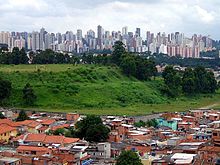
Poverty continues to be one of the region's main challenges; according to the ECLAC, Latin America is the most unequal region in the world. Inequality is undermining the region's economic potential and the well-being of its population, since it increases poverty and reduces the impact of economic development on poverty reduction. Children in Latin America are often forced to seek work on the streets when their families can no longer afford to support them, leading to a substantial population of street children in Latin America. According to some estimates, there are 40 million street children in Latin America. Inequality in Latin America has deep historical roots that have been difficult to eradicate since the differences between initial endowments and opportunities among social groups have constrained the poorest's social mobility, thus making poverty to be transmitted from generation to generation, becoming a vicious cycle. High inequality is rooted in exclusionary institutions that have been perpetuated ever since colonial times and that have survived different political and economic regimes. Inequality has been reproduced and transmitted through generations because Latin American political systems allow a differentiated access on the influence that social groups have in the decision making process, and it responds in different ways to the least favored groups that have less political representation and capacity of pressure. Recent economic liberalisation also plays a role as not everyone is equally capable of taking advantage of its benefits. Differences in opportunities and endowments tend to be based on race, ethnicity, rurality and gender. Those differences have a strong impact on the distribution of income, capital and political standing.
According to a study by the World Bank,the richest decile of the population of Latin America earn 48% of the total income, while the poorest 10% of the population earn only 1.6% of the income. In contrast, in developed countries, the top decile receives 29% of the total income, while the bottom decile earns 2.5%. The countries with the highest inequality in the region (as measured with the Gini index in the UN Development Report) in 2007 were Haiti (59.5), Colombia (58.5), Bolivia (58.2), Honduras (55.3), Brazil (55.0), and Panama (54.9), while the countries with the lowest inequality in the region were Venezuela (43.4), Uruguay (46.4) and Costa Rica (47.2).
According to the World Bank the poorest countries in the region were (as of 2008): Haiti, Nicaragua, Bolivia and Honduras. Undernourishment affects to 47% of Haitians, 27% of Dominicans and Nicaraguans, 23% of Bolivians and 22% of Hondurans.
Many countries in Latin America have responded to high levels of poverty by implementing new, or altering old, social assistance programs such as conditional cash transfers. These include Mexico's Progresa Oportunidades, Brazil's Bolsa Escola and Bolsa Familia, Panama's Red de Oportunidades and Chile's Chile Solidario. In general, these programs provide money to poor families under the condition that those transfers are used as an investment on their children's human capital, such as regular school attendance and basic preventive health care. The purpose of these programs is to address the inter-generational transmission of poverty and to foster social inclusion by explicitly targeting the poor, focusing on children, delivering transfers to women, and changing social accountability relationships between beneficiaries, service providers and governments. These programs have helped to increase school enrollment and attendance and they also have shown improvements in children's health conditions. Most of these transfer schemes are now benefiting around 110 million people in the region and are considered relatively cheap, costing around 0.5% of their GDP. In some countries e.g. in Peru decentralisation is hoped to help addressing social justice and poverty better. NGOs which addressed those problems on the local level before could help with that.
Trade blocs
The major trade blocs (or agreements) in the region are the Union of South American Nations, composed of the integrated Mercosur and Andean Community of Nations (CAN). Minor blocs or trade agreements are the G3 Free Trade Agreement, the Dominican Republic – Central America Free Trade Agreement (DR-CAFTA) and the Caribbean Community (CARICOM). However, major reconfigurations are taking place along opposing approaches to integration and trade; Venezuela has officially withdrawn from both the CAN and G3 and it has been formally admitted into the Mercosur (pending ratification from the Paraguayan legislature). The president-elect of Ecuador has manifested his intentions of following the same path. This bloc nominally opposes any Free Trade Agreement (FTA) with the United States, although Uruguay has manifested its intention otherwise. Chile has already signed an FTA with Canada, and along with Peru, Colombia and Mexico are the only four Latin American nations that have an FTA with the United States, the latter being a member of the North American Free Trade Agreement (NAFTA).
Metropolitan economies
The following table provides estimated GDP figures for the largest metropolitan areas in Latin America.
| Rank | Metropolitan area |
Country | GDP (PPP) (2008) Billions of US$ |
Metropolitan population (2006) Millions |
GDP (PPP) US$ per capita |
|---|---|---|---|---|---|
| 1 | Mexico City | 390 | 21.2 | 20,300 | |
| 2 | São Paulo | 388 | 18.61 | 20,800 | |
| 3 | Buenos Aires | 362 | 13.52 | 28,000 | |
| 4 | Rio de Janeiro | 201 | 11.62 | 17,300 | |
| 5 | Bogotá | 180 | 8.55 | 21,050 | |
| 6 | Santiago | 120 | 5.70 | 21,050 | |
| 7 | Brasilia | 110 | 3.48 | 31,600 | |
| 8 | Lima | 109 | 8.35 | 13,100 | |
| 9 | Medellín | 102 | 3.58 | 28,500 | |
| 10 | Guadalajara | 81 | 3.95 | 20,500 |
Note: The GDP data are for 2008 while the population data are for 2006. The GDP per capita figures were obtained by dividing these two sets of data, so the results may not accurately reflect the GDP per capita for 2008.
Tourism

Income from tourism is key to the economy of several Latin American countries. Mexico receives the largest number of international tourists, with 22.3 million visitors in 2010, followed by Argentina, with 5.2 million in 2010; Brazil, with 5.1 million; Colombia with 4.35 million;, Puerto Rico, with 3.6 million, Chile with 2.7 million; Dominican Republic, with 4.1 million and Panama with 2.06 million. Places such as Cancún, Galápagos Islands, Machu Picchu, Chichen Itza, Cartagena de Indias, Cabo San Lucas, Acapulco, Rio de Janeiro, Salvador, Margarita Island, São Paulo, Salar de Uyuni, Punta del Este, Santo Domingo, Labadee, San Juan, La Habana, Panama City, Iguazu Falls, Puerto Vallarta, Poás Volcano National Park, Punta Cana, Viña del Mar, Mexico City, Quito, Bogotá, Santa Marta, San Andrés, Buenos Aires, Lima, Maceió, Florianópolis, Cuzco and Patagonia are popular among international visitors in the region.
| Country | Tourist arrivals (2011) (Millions) |
Tourism receipts (2011) (Millions of US$) |
Tourism receipts (2011) (US$ per arrival) |
Tourism receipts (2011) (US$ per capita) |
Tourism receipts (2003) (as % of GDP) |
Tourism receipts (2003) (as % of exports) |
Direct and indirect employment in tourism (2005) (%) |
Tourism competitiveness (2011) (TTCI) |
|---|---|---|---|---|---|---|---|---|
| 5.663 | 5,353 | 945 | 133 | 7.4 | 1.8 | 9.1 | 4.20 | |
| 0.807 | 310 | 384 | 31 | 9.4 | 2.2 | 7.6 | 3.35 | |
| 5.433 | 6,555 | 1,207 | 34 | 3.2 | 0.5 | 7.0 | 4.36 | |
| 3.070 | 1,831 | 596 | 107 | 5.3 | 1.9 | 6.8 | 4.27 | |
| 4.356 | 4,061 | 873 | 45 | 6.6 | 1.4 | 5.9 | 3.94 | |
| 2.196 | 2,156 | 982 | 459 | 17.5 | 8.1 | 13.3 | 4.43 | |
| 2.507 | 2,187 | 872 | 194 | N/A | N/A | N/A | N/A | |
| 4.306 | 4,353 | 1,011 | 440 | 36.2 | 18.8 | 19.8 | 3.99 | |
| 1.141 | 837 | 734 | 58 | 6.3 | 1.5 | 7.4 | 3.79 | |
| 1.184 | 415 | 351 | 67 | 12.9 | 3.4 | 6.8 | 3.68 | |
| 1.225 | 1,350 | 1,102 | 94 | 16.0 | 2.6 | 6.0 | 3.82 | |
| 0.255 | 167 | 655 | 17 | 19.4 | 3.2 | 4.7 | N/A | |
| 0.931 | 701 | 753 | 92 | 13.5 | 5.0 | 8.5 | 3.79 | |
| 23.403 | 11,869 | 507 | 105 | 5.7 | 1.6 | 14.2 | 4.43 | |
| 1.060 | 377 | 356 | 65 | 15.5 | 3.7 | 5.6 | 3.56 | |
| 2.06 | 1,926 | 1,308 | 550 | 10.6 | 6.3 | 12.9 | 4.30 | |
| 0.524 | 241 | 460 | 37 | 4.2 | 1.3 | 6.4 | 3.26 | |
| 2.598 | 2,360 | 908 | 81 | 9.0 | 1.6 | 7.6 | 4.04 | |
| 2.857 | 2,187 | 765 | 643 | 14.2 | 3.6 | 10.7 | 4.24 | |
| 0.510 | 739 | 1,449 | 25 | 1.3 | 0.4 | 8.1 | 3.46 |
Culture
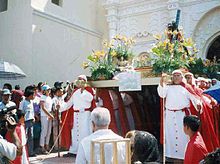
Latin American culture is a mixture of many cultural expressions worldwide. It is the product of many diverse influences:
- Indigenous cultures of the people who inhabited the continent prior to the arrival of the Europeans. Ancient and very advanced civilizations developed their own political, social and religious systems. The Maya, the Aztecs and the Incas are examples of these.
- Western civilization, in particular the culture of Europe, was brought mainly by the colonial powers – the Spanish, Portuguese and French – between the 16th and 19th centuries. The most enduring European colonial influence is language and Roman Catholicism. More recently, additional cultural influences came from the United States and Europe during the nineteenth and twentieth centuries, due to the growing influence of the former on the world stage and immigration from the latter. The influence of the United States is particularly strong in northern Latin America, especially Puerto Rico, which is a United States territory. Prior to 1959 Cuba, who fought for its independence along American soldiers in the Spanish-American War, was also known to have a close socioeconomic relation with the United States. In addition, the United States also helped Panama become an independent state from Colombia and built the twenty-mile-long Panama Canal Zone in Panama which held from 1903 (the Panama Canal opened to transoceanic freight traffic in 1914) to 1999, when the Torrijos-Carter Treaties restored Panamanian control of the Canal Zone. South America experienced waves of immigration of Europeans, especially Italians, Spaniards, Portuguese and Germans. With the end of colonialism, French culture was also able to exert a direct influence in Latin America, especially in the realms of high culture, science and medicine. This can be seen in any expression of the region's artistic traditions, including painting, literature and music, and in the realms of science and politics.
- African cultures, whose presence derives from a long history of New World slavery. Peoples of African descent have influenced the ethno-scapes of Latin America and the Caribbean. This is manifested for instance in music, dance and religion, especially in countries like Belize, Brazil, Honduras, Puerto Rico, Venezuela, Colombia, Panama, Haiti, Costa Rica, Dominican Republic, and Cuba.
Art

Beyond the rich tradition of indigenous art, the development of Latin American visual art owed much to the influence of Spanish, Portuguese and French Baroque painting, which in turn often followed the trends of the Italian Masters. In general, this artistic Eurocentrism began to fade in the early twentieth century, as Latin-Americans began to acknowledge the uniqueness of their condition and started to follow their own path.
From the early twentieth century, the art of Latin America was greatly inspired by the Constructivist Movement. The Movement quickly spread from Russia to Europe and then into Latin America. Joaquín Torres García and Manuel Rendón have been credited with bringing the Constructivist Movement into Latin America from Europe.
An important artistic movement generated in Latin America is muralism represented by Diego Rivera, David Alfaro Siqueiros, José Clemente Orozco and Rufino Tamayo in Mexico and Santiago Martinez Delgado and Pedro Nel Gómez in Colombia. Some of the most impressive Muralista works can be found in Mexico, Colombia, New York City, San Francisco, Los Angeles and Philadelphia.
Painter Frida Kahlo, one of the most famous Mexican artists, painted about her own life and the Mexican culture in a style combining Realism, Symbolism and Surrealism. Kahlo's work commands the highest selling price of all Latin American paintings.
Colombian sculptor and painter Fernando Botero is also widely known by his works which, on first examination, are noted for their exaggerated proportions and the corpulence of the human and animal figures.
Film
Latin American film is both rich and diverse. Historically, the main centers of production have been Mexico, Argentina, Brazil, and Cuba.
Latin American film flourished after sound was introduced in cinema, which added a linguistic barrier to the export of Hollywood film south of the border. The 1950s and 1960s saw a movement towards Third Cinema, led by the Argentine filmmakers Fernando Solanas and Octavio Getino. More recently, a new style of directing and stories filmed has been tagged as "New Latin American Cinema".
Mexican cinema started out in the silent era from 1896 to 1929 and flourished in the Golden Era of the 1940s. It boasted a huge industry comparable to Hollywood at the time with stars such as María Félix, Dolores del Río, and Pedro Infante. In the 1970s, Mexico was the location for many cult horror and action movies. More recently, films such as Amores Perros (2000) and Y tu mamá también (2001) enjoyed box office and critical acclaim and propelled Alfonso Cuarón and Alejandro González Iñarritu to the front rank of Hollywood directors. Alejandro González Iñárritu directed in (2006) Babel and Alfonso Cuarón directed ( Children of Men in (2006), and Harry Potter and the Prisoner of Azkaban in (2004)). Guillermo del Toro close friend and also a front rank Hollywood director in Hollywood and Spain, directed Pan's Labyrinth (2006) and produce El Orfanato (2007). Carlos Carrera ( The Crime of Father Amaro), and screenwriter Guillermo Arriaga are also some of the most known present-day Mexican film makers. Rudo y Cursi released in December (2008) in Mexico directed by Carlos Cuarón.
Argentine cinema has also been prominenent since the first half of the 20th century and today averages over 60 full-length titles yearly. The industry suffered during the 1976–1983 military dictatorship; but re-emerged to produce the Academy Award winner The Official Story in 1985. A wave of imported U.S. films again damaged the industry in the early 1990s, though it soon recovered, thriving even during the Argentine economic crisis around 2001. Many Argentine movies produced during recent years have been internationally acclaimed, including Nueve reinas (2000), El abrazo partido (2004), El otro (2007) and the 2010 Foreign Language Academy Award winner El secreto de sus ojos.
In Brazil, the Cinema Novo movement created a particular way of making movies with critical and intellectual screenplays, a clearer photography related to the light of the outdoors in a tropical landscape, and a political message. The modern Brazilian film industry has become more profitable inside the country, and some of its productions have received prizes and recognition in Europe and the United States, with movies such as Central do Brasil (1999), Cidade de Deus (2002) and Tropa de Elite (2007).
Cuban cinema has enjoyed much official support since the Cuban revolution and important film-makers include Tomás Gutiérrez Alea.
It is also worth noting that many Latin Americans have achieved significant success within Hollywood, for instance Carmen Miranda (Portuguese-Brazilian), Salma Hayek (Mexican), and Benicio del Toro (Puerto Rican), while Mexican Americans such as Robert Rodriguez have also made their mark in film production.
Literature
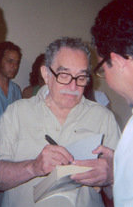

Pre-Columbian cultures were primarily oral, though the Aztecs and Mayans, for instance, produced elaborate codices. Oral accounts of mythological and religious beliefs were also sometimes recorded after the arrival of European colonizers, as was the case with the Popol Vuh. Moreover, a tradition of oral narrative survives to this day, for instance among the Quechua-speaking population of Peru and the Quiché (K'iche') of Guatemala.
From the very moment of Europe's "discovery" of the continent, early explorers and conquistadores produced written accounts and crónicas of their experience – such as Columbus's letters or Bernal Díaz del Castillo's description of the conquest of Mexico. During the colonial period, written culture was often in the hands of the church, within which context Sor Juana Inés de la Cruz wrote memorable poetry and philosophical essays. Towards the end of the 18th Century and the beginning of the 19th, a distinctive criollo literary tradition emerged, including the first novels such as Lizardi's El Periquillo Sarniento (1816).
The 19th century was a period of "foundational fictions" (in critic Doris Sommer's words), novels in the Romantic or Naturalist traditions that attempted to establish a sense of national identity, and which often focussed on the indigenous question or the dichotomy of "civilization or barbarism" (for which see, say, Domingo Sarmiento's Facundo (1845), Juan León Mera's Cumandá (1879), or Euclides da Cunha's Os Sertões (1902)). The 19th century also witnessed the realist work of Machado de Assis, who made use of surreal devices of metaphor and playful narrative construction, much admired by critic Harold Bloom.
At the turn of the 20th century, modernismo emerged, a poetic movement whose founding text was Nicaraguan poet Rubén Darío's Azul (1888). This was the first Latin American literary movement to influence literary culture outside of the region, and was also the first truly Latin American literature, in that national differences were no longer so much at issue. José Martí, for instance, though a Cuban patriot, also lived in Mexico and the U.S. and wrote for journals in Argentina and elsewhere.
However, what really put Latin American literature on the global map was no doubt the literary boom of the 1960s and 1970s, distinguished by daring and experimental novels (such as Julio Cortázar's Rayuela (1963)) that were frequently published in Spain and quickly translated into English. The Boom's defining novel was Gabriel García Márquez's Cien años de soledad (1967), which led to the association of Latin American literature with magic realism, though other important writers of the period such as the Peruvian Mario Vargas Llosa and Carlos Fuentes do not fit so easily within this framework. Arguably, the Boom's culmination was Augusto Roa Bastos's monumental Yo, el supremo (1974). In the wake of the Boom, influential precursors such as Juan Rulfo, Alejo Carpentier, and above all Jorge Luis Borges were also rediscovered.
Contemporary literature in the region is vibrant and varied, ranging from the best-selling Paulo Coelho and Isabel Allende to the more avant-garde and critically acclaimed work of writers such as Diamela Eltit, Giannina Braschi, Ricardo Piglia, or Roberto Bolaño. There has also been considerable attention paid to the genre of testimonio, texts produced in collaboration with subaltern subjects such as Rigoberta Menchú. Finally, a new breed of chroniclers is represented by the more journalistic Carlos Monsiváis and Pedro Lemebel.
The region boasts six Nobel Prize winners: in addition to the two Chilean poets Gabriela Mistral (1945) and Pablo Neruda (1971), there is also the Colombian writer Gabriel García Márquez (1982), the Guatemalan novelist Miguel Ángel Asturias (1967), the Mexican poet and essayist Octavio Paz (1990), and the Peruvian novelist Mario Vargas Llosa (2010).
Music and dance

Latin America has produced many successful worldwide artists in terms of recorded global music sales. Among the most successful have been Gloria Estefan (Cuba) and Roberto Carlos (Brazil), both of whom have sold over 100 million records, Carlos Santana (Mexico) with over 75 million, Luis Miguel (Mexico), Shakira (Colombia) and Vicente Fernández (Mexico) with over 50 million records sold worldwide.
Caribbean Hispanic music, such as merengue, bachata, salsa, and more recently reggaeton, from such countries as the Dominican Republic, Puerto Rico, Trinidad, Cuba, and Panama has been strongly influenced by African rhythms and melodies. Haiti's compas is a genre of music that draws influence and is thus similar to its Caribbean Hispanic counterparts, with an element of jazz and modern sound as well.
Another well-known Latin American musical genre includes the Argentine and Uruguayan tango, as well as the distinct nuevo tango, a fusion of tango, acoustic and electronic music popularized by bandoneón virtuoso Ástor Piazzolla. Samba, North American jazz, European classical music and choro combined to form bossa nova in Brazil, popularized by guitarrist João Gilberto and pianist Antonio Carlos Jobim.
Other influential Latin American sounds include the Antillean soca and calypso, the Honduras (Garifuna) punta, the Colombian cumbia and vallenato, the Chilean cueca, the Ecuadorian boleros, and rockoleras, the Mexican ranchera and the mariachi which is the epitome of Mexican soul, the Nicaraguan palo de Mayo, the Peruvian marinera and tondero, the Uruguayan candombe, the French Antillean zouk (derived from Haitian compas) and the various styles of music from pre-Columbian traditions that are widespread in the Andean region.
The classical composer Heitor Villa-Lobos (1887–1959) worked on the recording of native musical traditions within his homeland of Brazil. The traditions of his homeland heavily influenced his classical works. Also notable is the recent work of the Cuban Leo Brouwer and guitar work of the Venezuelan Antonio Lauro and the Paraguayan Agustín Barrios. Latin America has also produced world-class classical performers such as the Chilean pianist Claudio Arrau, Brazilian pianist Nelson Freire and the Argentine pianist and conductor Daniel Barenboim.
Arguably, the main contribution to music entered through folklore, where the true soul of the Latin American and Caribbean countries is expressed. Musicians such as Yma Súmac, Chabuca Granda, Atahualpa Yupanqui, Violeta Parra, Víctor Jara, Facundo Cabral, Mercedes Sosa, Jorge Negrete, Luiz Gonzaga, Caetano Veloso, Susana Baca, Chavela Vargas, Simon Diaz, Julio Jaramillo, Toto la Momposina as well as musical ensembles such as Inti Illimani and Los Kjarkas are magnificent examples of the heights that this soul can reach.
Latin pop, including many forms of rock, is popular in Latin America today (see Spanish language rock and roll).
More recently, Reggaeton, which blends Jamaican reggae and dancehall with Latin America genres such as bomba and plena, as well as that of hip hop, is becoming more popular, in spite of the controversy surrounding its lyrics, dance steps ( Perreo) and music videos. It has become very popular among populations with a "migrant culture" influence – both Latino populations in the U.S., such as southern Florida and New York City, and parts of Latin America where migration to the U.S. is common, such as Puerto Rico, Trinidad, Dominican Republic, Colombia, Ecuador, El Salvador, and Mexico.


